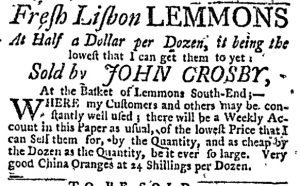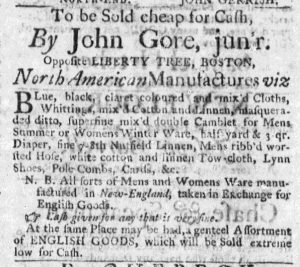What was advertised in a colonial American newspaper 250 years ago today?

“Any Branch of the Painting and Gilding Business.”
George Kilcup’s advertisement in the June 29, 1769, edition of the Boston Weekly News-Letter likely garnered attention due to it unique format and placement on the first page. The short advertisement ran across the bottom of the page, separated from the news items that appeared above it by a line that helped readers distinguish between the two types of content. Rather than run continuously across all three columns, the advertisement was also divided into three columns with three lines of text each. While it was not uncommon for advertisements to run on the front page of eighteenth-century newspapers, this format and placement was quite exceptional.
The needs of the printer rather than any sort of intentional design by the advertiser or compositor likely explain the unusual manner of presenting this advertisement. Notably, the advertisement did not appear in the same form in subsequent insertions. The following week it ran as a block of text confined to a single column, like all of the other advertisements on the page. It took the form readers were accustomed to seeing in the pages of newspapers. Apparently the compositor set the advertisement in three columns, rather than in lines that crossed the entire page like the masthead, for the sake of efficiency. Knowing that the advertisement would run again the following week, the compositor set it in columns that could be rearranged easily into a standard block of text rather than having to reset the type completely.
Inserting Kilcup’s advertisement on the front page at all seems to have been a decision made at the last moment as a partial solution to the lack of space for all the content the printer could have included in the June 29 edition. The issue ended with a brief note informing readers, correspondents, and advertisers that “The Articles of Intelligence and Advertisements omitted, will be in our next.” Yet advertisers paid to have their notices inserted, and newspaper printers depended on this important revenue stream. The text that bled through the second page to the first suggests that the compositor originally planned for shorter columns on the first page but later modified it to include Kilcup’s advertisement when running short of space elsewhere in the issue. The compositor managed to squeeze in one more advertisement to mollify a client who might not have been happy for his notice to be delayed by a week.
Printers and compositors and, sometimes, advertisers experimented with graphic design elements of advertisements in eighteenth-century newspapers, yet not all innovations derived from intentionally attempting to devise a combination of format and placement to draw the attention of readers to advertisements. In the case of Kilcup’s advertisement, transformed into the standard block of text at the first opportunity, it seems that necessity prompted the compositor to play with the usual format and placement after the printer compiled too much content to fit all of it in the newspaper that week. That does not negate the fact that Kilcup’s advertisement benefited from enhanced visibility for its first insertion, but that does not seem to have been the first priority of anyone involved in producing the advertisement.









